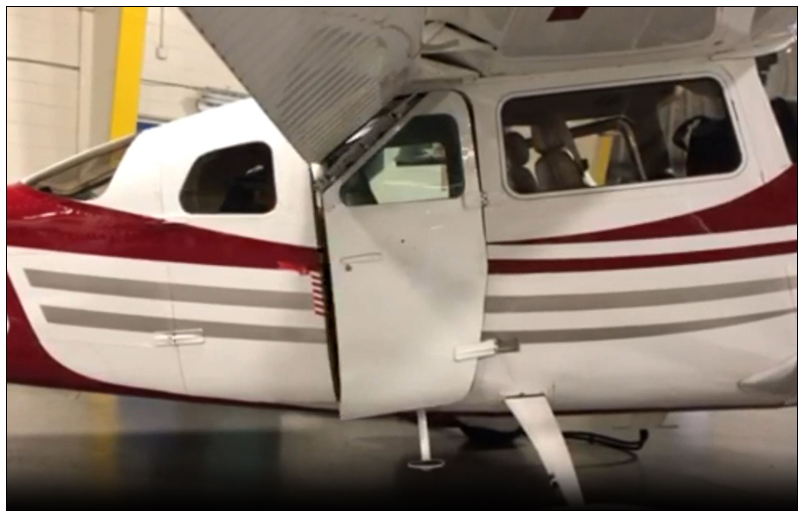Safety advisory notice
To operators of all Cessna 206 variants
The removal of a middle row seat or approved cargo door modifications can improve the survivability for occupants of the Cessna 206.
What happened
On the morning of 1 September 2024, the pilot of a Cessna U206F took off from a private aircraft landing area, 40 km south-east of Moora, Western Australia, to conduct a local scenic flight with 5 passengers on board. On return to the landing area, after bouncing twice on landing, the pilot then attempted to conduct a go-around. However, an incorrect flap setting resulted in the aircraft not climbing, impacting the right wing with terrain before coming to a stop in an adjacent field.

The rear seat passengers, an older person and a child, were unable to egress the aircraft via their closest emergency exit (the cargo doors). The pilot tried assisting them but found that the forward cargo door was blocked due to the flap extension and was unaware how to open the rear cargo door with the forward cargo door blocked by the flap. The pilot attempted to retract the flaps so the door could be opened, but they would not retract. The pilot then instructed the passengers in the rear seats to climb over the middle row of seats so they could exit through the left forward cabin door. This ultimately increased the time taken to evacuate the aircraft and further increased the risk of passenger injury and post-impact survivability, such as if fire or ditching had been a factor.
Why did it happen
The Cessna 206 is a 6‑seat, high wing aircraft with a forward cabin door on the pilot’s side and a double cargo ‘clam-shell’ style door on the rear right hand side of the aircraft. When the aircraft flaps are extended 10° or more, this prevents the forward, overlapping part of the cargo door from opening, requiring a multi-step process to open the rear part of the door to exit the aircraft.
In response to a fatal Canadian Cessna 206 accident in 2018, Transport Canada issued Airworthiness Directive CF-2020-10 requiring Canadian registered Cessna 206 aircraft to have one of the second row (middle row) seats removed if passengers were to be seated in the rear seats of the aircraft. The airworthiness directive was introduced due to aircraft occupants being unable to evacuate the aircraft during an emergency and allowed the rear seat passengers easier access to the forward cargo door. At the time, the Canadian airworthiness directive did provide for an alternative means of compliance to the removal of a middle row seat with a supplemental type certificate (STC) STC SA1470GL, for the installation of a second forward cabin door located adjacent to the forward right seat.
In 2020, STC SA20-34 was approved as an alternative means of compliance, which allowed the forward cargo door corner to be hinged so the door corner can fold and the door fully open with flap extended in any position and without any restriction to the rear cargo door.
In 2023, Transport Canada also approved STC SA23-21 to provide an additional handle that is installed internally on the forward cargo door. The handle is accessible to the rear seat passengers, which, when activated, jettisons the front cargo door from the aircraft. The removal of the door provided enhanced egress to the middle row occupants when flaps remained extended. The release of the door from the aircraft also improved visibility of the rear cargo door handle and simplified opening the rear cargo door for occupants in the rear seats.
In 2021, CASA issued Airworthiness Bulletin 52‑006 recommending operators consider incorporating the changes Transport Canada had enforced.
Safety advisory notice
AO-2024-049-SAN-002: The Australian Transport Safety Bureau strongly encourages operators and owners to review Transport Canada Airworthiness Directive CF‑2020-10, and consider either the removal of a middle row seat to improve rear seat occupants’ access to the pilot’s forward left cabin door or the fitment of approved Cessna 206 emergency exit modifications to reduce the risk created by the extended flap preventing the immediate and unobstructed use of the rear cargo doors during an emergency exit.

Cessna 206 emergency egress modifications
The additional complexity involved with opening the rear cargo door of the Cessna 206 when the flaps remain extended requires a multi-step process that is not intuitive or simple.
Transport Canada made significant changes to the aircraft configuration mandating the removal of a middle row seat and therefore providing access for passengers in the rear seats and improved access to the pilot’s forward left door. As an alternative to the removal of a seat, Transport Canada also approved modifications that either provided an additional exit or modification to the cargo door, so as the extended flap does not block the forward cargo door exit.
Australian operators of Cessna 206 aircraft that feature the double cargo door are strongly encouraged to review the changes Transport Canada has mandated, or the approved modifications, and consider implementing the improvements for the survivability for passengers during emergency egress in the Cessna 206.
Read more about this ATSB investigation: Collision with terrain during go-around involving Cessna U206F, VH-TDQ, 39 km south-east of Moora, Western Australia, on 1 September 2024


